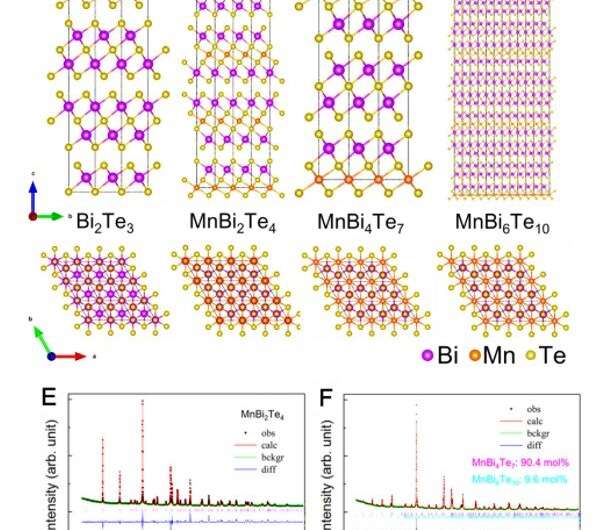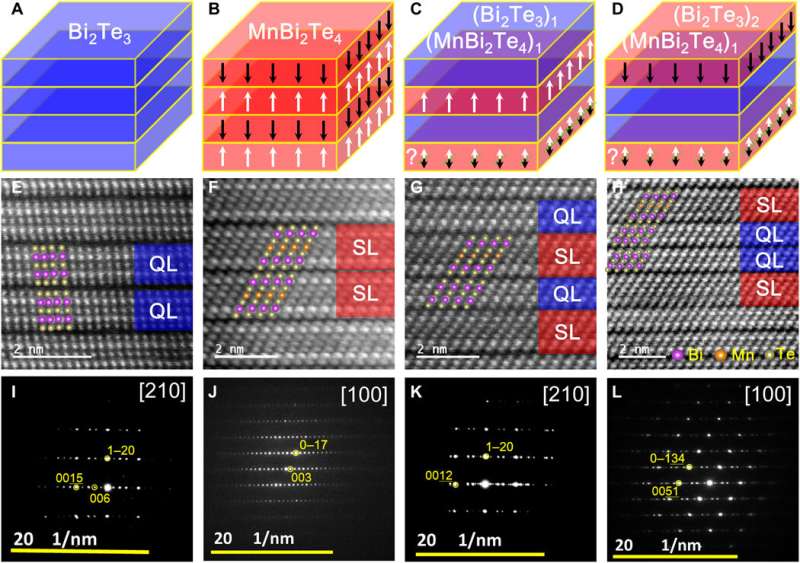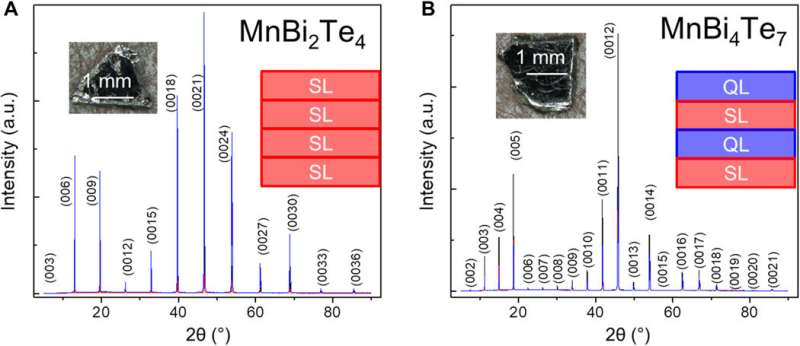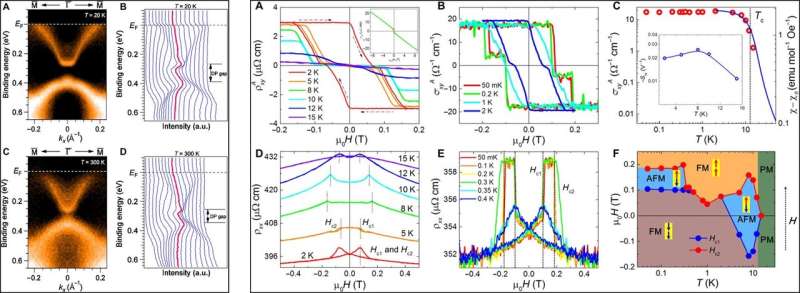November 27, 2019 feature
Natural van der Waals heterostructural single crystals with magnetic and topological properties

Heterostructures with magnetism and topology (geometry) are promising materials to realize exotic topological quantum states. However, such materials are challenging to engineer or synthesize. In a new report on Science Advances, Jiazhen Wu and an interdisciplinary research team in the departments of Materials Research, Optoelectronic Science, Physics, Condensed Matter Research and Advanced Materials in Japan and China, reported the development of natural magnetic van der Waals heterostructures. The constructs exhibited controllable magnetic properties while maintaining their topological surface states.
During the process, the materials scientists and physicists gradually weakened the interlayer antiferromagnetic exchange coupling while increasing magnetic layer separation to observe an anomalous Hall effect. At a temperature below 5K, the phenomenon was well coupled with magnetization to cause ferromagnetic hysteresis i.e., applying an external magnetic field to a ferromagnet causing the alignment of its atomic dipoles. The researchers aim to use the homogeneous heterostructures with atomically sharp interfaces and intrinsic magnetic properties to study exotic phenomena such as the quantum anomalous Hall effect, axion insulator states and topological magnetoelectric effects (the induction of magnetization by an electric field and the induction of electric polarization by a magnetic field).
In condensed matter physics, magnetic heterostructures have attracted considerable attention to form new applications in the developing fields of spintronics and topotronics (nanoelectronics based on topological structures). For example, well-established deposition techniques that assist thin film growth including molecular beam epitaxy, pulsed laser deposition and sputtering have accelerated the field to facilitate unique properties such as giant magnetoresistance. For instance, tunneling magnetoresistance had previously demonstrated core technical capabilities for digital information storage. However, research developments of magnetic heterostructures remain limited due to associated deposition techniques, hindering wide-ranging studies of unique materials systems. Nevertheless, researchers recently used the transfer method to prepare van der Waals heterostructures intricately with sophisticated techniques.
Researchers had also recently developed heterostructures combined with magnetic layers and topological insulator (TI) layers to form exotic topological quantum states. But the development of an ideal platform to study quantum effects using a homogenous heterostructure containing atomically sharp interfaces and intrinsic magnetic properties remains experimentally elusive. In this work, Wu et al. reported naturally occurring van der Waals heterostructures (MnBi2Te4)m(Bi2Te3)m with controllable magnetic properties and topological surface states (SSs). They prepared single crystals using the flux method (method of crystal growth) and identified variants of the molecules using X-ray diffraction (XRD) measurements and scanning transmission electron microscopy (STEM). When the research team gradually weakened the interlayer antiferromagnetic (AFM) exchange interactions, the materials converted into a magnetic order competing system with a ferromagnetic (FM) state stabilized below 5K.

Since the magnetization had an out-of-plane easy axis, the researchers observed an anomalous Hall (AH) effect—well coupled with magnetization. They investigated the nontrivial electronic structures of MnBi4Te7 in the bulk and surface using density functional theory (DFT) calculations to confirm its antiferromagnetic topological insulator (AFM TI) properties. Wu et al. experimentally detected the surface states using angle-resolved photoemission spectroscopy (ARPES) measurements and expect the novel material to provide a platform to investigate varied interests in spintronics and topotronics.
For example, the recently reported MnBi2Te4 synthetic compound is an intrinsic van der Waals antiferromagnet showing topological nontrivial surface states (SS). Since the two van der Waals materials Bi2Te3 and MnBi2Te4 demonstrated similar lattice constraints, the researchers were keen to test the possibility of synthesizing natural heterostructures with alternating quintuple atomic layers (QLs) and septuple atomic layers (SLs).
Based on the assumption, the researchers prepared polycrystalline samples relative to the formulation of (MnBi2Te4)m(Bi2Te3)nand formed MnBi4Te7 and MnBi6Te10 using a solid-state reaction route. The research team observed the new heterostructures using high-angle annular dark-field (HAADF) and STEM measurements. The atomic resolution images were highly consistent with the crystal structures previously obtained using XRD measurements and aligned with the proposed model. They further confirmed high degrees of crystallinity of the prepared samples using selected-area electron diffraction (SAED) patterns.

To test the physical properties, Wu et al. then grew single crystals of MnBi2Te4 and MnBi4Te7 using a flux-assisted method and found the synthesis to be difficult since the phases only evolved at a very narrow temperature range. The scientists showed MnBi4Te7 to be comparatively more complex due to the presence of both QL and SL (quintuple and septuple) atomic layers. The researchers checked the fresh surface of the samples using Auger electron spectroscopy and X-ray photoelectron spectroscopy under high vacuum and results indicated the samples to be clean and confirmed the presence of all the proposed elements (manganese [Mn], bismuth [Bi] and tellurium [Te]).
To understand the magnetic structures, Wu et al. next conducted magnetization measurements of the single-crystalline samples MnBi2Te4 and MnBi4Te7. The two compounds showed contrasting magnetic structures. For additional insight into the electronic structure and topology of MnBi4Te7, the research team conducted DFT (density functional theory) calculations using the hybrid functional method, which is widely used to study small band-gap materials. The team demonstrated band structures of the bulk MnBi4Te7 compound with and without spin-orbit coupling (SOC).
![LEFT: Magnetic properties of MnBi2Te4 and MnBi4Te7 single crystals. (A to C) Magnetic susceptibility and magnetization of MnBi2Te4. The parameters θ and μeff are the Curie-Weiss temperature and effective moment, respectively. (D to F) Magnetic susceptibility and magnetization of MnBi4Te7 at high fields. (G to I) Magnetic susceptibility and magnetization of MnBi4Te7 at low fields. The black arrows with dotted lines in (I) show the sweep directions of the magnetic field. The heterostructures and spin structures are schematically shown as insets in (B), (C), (E), (F), and (I). RIGHT: DFT band structures of MnBi4Te7. (A) Bulk band structure without SOC. (B) Bulk band structure with SOC. (C) Band structure of a QL-terminated five–van der Waals layer slab. (D) Band structure of an SL-terminated seven–van der Waals layer slab. The calculations were performed assuming an AFM ground state. The thickness of the band is proportional to the contribution of the indicated atoms (A and B) or van der Waals layers [QL/SL in (C) and (D)]. Credit: Science Advances, doi: 10.1126/sciadv.aax9989. Natural van der Waals heterostructural single crystals with magnetic and topological properties](https://scx1.b-cdn.net/csz/news/800a/2019/3-naturalvande.jpg)
Thereafter, the scientists measured the surface state of MnBi4Te7 using ARPES (angle-resolved photoemission spectroscopy) at 20 and 300 K with an excitation photon energy of 48 eV similar to a previous investigation. Compared with the calculated results, they observed the measured surface states to be derived mainly from the SL-(septuple atomic layer), although they did not exclude contributions from the QL-(quintuple atomic layer). To explain the observations, the scientists also considered the possibility of the QL/SL surface domain sizes being much smaller than the photon beam spot size employed for spectroscopic (ARPES) analysis.
Wu et al. observed ferromagnetic spin fluctuations in MnBi4Te7 above the transition temperature (TN) and credited them to the results observed within the setup. The results however prompted an open question requiring further investigations. Notably, surface states of the MnBi4Te7 were more complex than MnBi2Te4 by understanding the surface properties and tunable magnetic properties of the magnetic heterostructures the researchers will ideally be able to explore tunable quantized magnetoelectric phenomena in the future.
Wu et al. also recorded the electrical properties of MnBi4Te7 single crystals, which notably differed from the MnBi2Te4 variant. The compound had a metallic conductivity with the Hall effect showing a carrier concentration of 2.85 x 1020 cm-3 at 2 degrees Kelvin. The Hall resistivity had a linear field dependence at high fields to suggest a single carrier in the compound. Wu et al. characterized the anomalous electrical transport properties and magnetic structures of MnBi4Te7 single crystals to further show dependence of spin-flip transitions on magnetoresistance.

The associated electrons within the compound underwent a higher scattering rate at magnetoresistance plateaus (high-resistance state) than at a lower or higher magnetic field. The scientists observed that such magnetoresistance plateaus could not survive at higher temperatures (>0.35 K) since thermal activation could potentially destroy antiferromagnetic states prompting the system to enter a ferromagnetic state. Importantly, the plateaus in anomalous Hall conductivity resembled axion insulating states and therefore, the present system could also potentially form a platform to create appropriately tuned axion insulators. When current flows across the magnetic and nonmagnetic layers in the setup, the magnetoresistance effects can grow much stronger, similar to materials with giant magnetoresistance.
In this way, Jiazhen Wu and colleagues summarized the field- and temperature-dependent magnetic structures of MnBi4Te7,indicating the compound as a magnetic order competing system. Comparatively, they did not observe this competing situation with MnBi2Te4. The researchers expect the competing magnetic order of the compounds to induce unexplored quantum topological states. The experimental exotic magnetic structures of the present materials will lead to fundamental interests in magnetism. The work will also provide a new platform for topotronics to realize quantized magnetoelectronic phenomena. The successful isolation of the van der Waals materials will provide both materials scientists and physicists brand new opportunities to study the interplay between magnetism and topology within two-dimensional limits.
More information: Jiazhen Wu et al. Natural van der Waals heterostructural single crystals with both magnetic and topological properties, Science Advances (2019). DOI: 10.1126/sciadv.aax9989
Qing Lin He et al. Tailoring exchange couplings in magnetic topological-insulator/antiferromagnet heterostructures, Nature Materials (2016). DOI: 10.1038/nmat4783
M. M. Otrokov et al. Unique Thickness-Dependent Properties of the van der Waals Interlayer Antiferromagnet MnBi2Te4 Films, Physical Review Letters (2019). DOI: 10.1103/PhysRevLett.122.107202
Journal information: Science Advances , Nature Materials , Physical Review Letters
© 2019 Science X Network





















